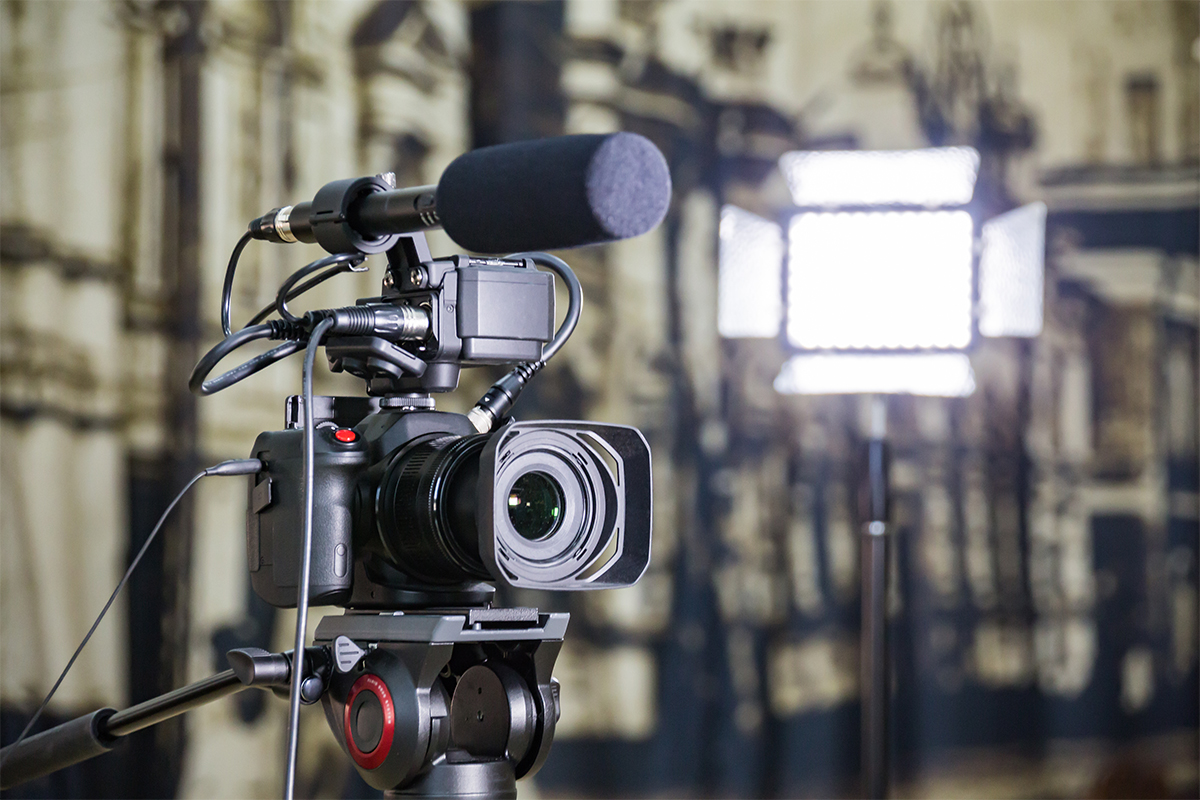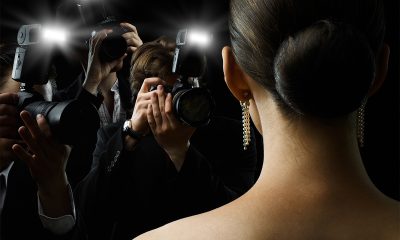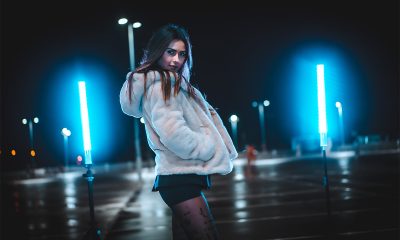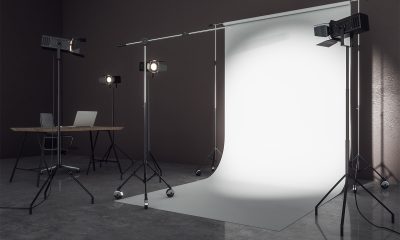The quality and quantity of light is highly influential in video production
In video, television and film production, the quality and quantity of light are essential to the delivery of proper exposure and color to the image. Videography and cinematography are arts of motion picture photography. They create moving pictures by recording radiation on a light-sensitive medium. The light-sensitive medium is either a photographic film or an electronic sensor which can be a charge-coupled device (CCD) sensor or a CMOS active-pixel sensor. The sensor in a digital video camera contains a great number of pixels, which, like the photoreceptors in our eyes, serve to collect photons of light. The light-sensitive photodiode within each pixel produces an electrical potential proportional to the received light intensity. Over individual pixels on the image sensor three filters that are sensitive to red, green and blue wavelengths are placed to sample color information. Effective lighting is the key to success in videography, TV broadcasting and cinematography. It is necessary to control and manipulate light correctly in order to get the best exposure, contrast, and visual perception of color.
Motion picture photography is all about capturing light
The light to which a video camera is exposed can make it a hit or a miss. To properly shape a scene a video lighting setup must be composed in layers. The various lighting techniques for video and motion pictures are essentially rooted in the three-point setup, the basic principle of still photography. A three-point lighting plan uses key lights, fill lights and back lights to create modelling, accentuate features and bring out details. Also called a main light, the key light is the primary light source illuminating the subject area of a scene. It is often placed slightly above and to one side of the video camera, illuminating the front of the subject to define the overall form and shape. The fill light is generally a floodlight that is placed on the opposite side of the video camera from the key light to fill in or soften the shadows created by the key light. The back light is designed to separate a subject from its background, thus highlighting contours and providing the illusion of depth. The quality of light produced by a key light can be characterized by how “hard” or “soft” the shadow it produces. Hard lights are directional and cast very distinct shadows. Soft lights produce relatively large area diffuse light and thus cast very few shadows.
Legacy lighting systems
In the past, Fresnel-lensed lights and open-faced instruments that incorporate tungsten, HMI, and fluorescent lamps had been the backbone of film and television lighting. Tungsten filament lamps produce optical radiation across the broadest spectrum, but also use the most power and radiate a large amount of heat. HMI lights are high intensity discharge (HID) sources that use mercury vapor mixed with metal halides in a quartz-glass envelope. They emit light when the pressurized mercury vapor is excited by an electrical arc between two electrodes within the bulb.
HMI lights provide very high light output with much greater efficiency and deliver a daylight spectrum with a color temperature of approximately 5600 degrees Kelvin. However, they are prone to risk of explosion over a period of use since the gases are present at a significantly high pressure. Other concerns with metal halide lighting is the production of ultraviolet (UV) light, long restrike times and poor dimmability. Fluorescent lamps, which produce diffused light by their very nature, are generally used for soft lighting applications. Yet the emitted spectrum of these lights is discontinuous and tend to be heavy in green. Dimming fluorescent lamps is also problematic.
LED technology sits at the very heart of today’s video lighting systems
Solid state lighting (SSL) based on light emitting diode (LED) technology is now leading a new revolution in TV and film production lighting. An electrical to optical power conversion efficiency (PCE) of over 60% and failure-free operation over the period over tens of thousands of hours are the least attractive advantages for the technology switch. LEDs have other characteristics that make them especially appealing to video lighting applications. Many of the newest digital video cameras are extremely light sensitive. Inappropriate intensity of lighting will cause the shot to be underexposed (all tones reproduce too dark) or overexposed (all tones reproduce too light). Providing illumination that is highly controllable is critical to a proper exposure. The instant, full range dimming capability of LEDs allows for delivery of the right amount of light on demand., which is not possible with HMI and fluorescent lamps.
Through bandgap energy manipulation, phosphor conversion or additive color mixing, LEDs can be designed to emit almost any spectrum of visible light, delivering the most desirable color attributes for color-critical video shooting applications.
LEDs are semiconductor devices that can work seamlessly with electronic logic circuits or processors. This unique feature affords video lighting instruments the chance to incorporate intelligent controllers and communications capabilities for new lighting features, functions, and benefits as well as increased networking of lighting devices that were not feasible with previous lighting technologies.

LED video lights
The downsizing of LEDs paved the way for advancing beyond legacy form factors to create more user-friendly, optically controllable lighting systems. The design of LED video lights is moving away from taking forms of conventional Fresnel spotlight, parabolic anodized reflector (PAR), light bank and ellipsoidal reflector spotlight (ERS) luminaires. Integrated LEDs directly into lightings systems significantly reduces the physical volume of the luminaires and enables more efficient delivery of light with the optimum optical distribution.
Despite the many video lighting instruments available, there are basically only two types: directional and diffused. Directional lights throw a controlled beam that illuminates a specific area. This product category includes spotlights and floodlights. Narrower beam directional lights can be used as hard light sources or long-distance projectors. Floodlights are used to model large objects or to provide soft light. Directional lights can also be used with soft boxes or umbrellas to create dispersed light. Diffused lighting systems are used to provide soft lighting with very uniform distribution without the use of soft boxes and umbrellas. Diffused LED video lights can be direct lighting panels that incorporate a large array of LEDs illuminating through an opal diffuser. Another type of LED soft lights are edge-lit LED panel lights which use a hybrid optical system to soften the harshness of LED light and provide completely homogeneous light.
Color quality
LED video lights use various types of LED packages, including plastic leaded chip carrier (PLCC) mid-power, chip scale package (CSP), chip-on-board (COB), and ceramic-based high power LED packages. White light is produced from phosphor-converted LEDs which utilize a semiconductor emitter to pump phosphors within the device package. The semiconductor emitter is an indium gallium nitride (InGaN) die with its bandgap manipulated such that the LED die emits blue or violet photons. While blue pump LEDs deliver the highest efficiency, violet pump LEDs have a more uniform spectral power distribution (SPD) and thus reproduce the colors of various objects more faithfully than blue pump LEDs.
The selection of color temperature and color rendering properties of the LEDs affects the apparent color of objects and the overall tone of a scene. The ultimate color characteristics of an LED are determined by the composition of its phosphor down-converter. Most white LEDs are designed to emit light in tungsten-halogen (3200K) or daylight (5600K) colors and also to provide high color rendering. The color rendition of video lighting equipment is typically measured using Television Lighting Consistency Index (TLCI), as opposed to the CRI (Color Rendering Index) and CQS (Color Quality Scale) and TM-30 color rendition metrics which were developed for human vision.
Spectral control
For static white systems, it’s an essential science to use color conversion gels for video and television production. White and color tunable luminaires provide the ability to dynamically tune the emitted spectrum of the light source, which removes the need for color filters. A tunable white LED system combine warm white LEDs (usually around 2700K) and cool white LEDs (usually around 6000K) to provide a continuously adjustable range of correlated color temperatures (CCTs) along the chromaticity line between chromaticity points of each CCT LED. Color tunable systems incorporate multiple colored LEDs which include three primaries (red, green and blue) and may use additional colors such as amber, white, and/or lime to expand the gamut. These luminaires provide the ability to additively mix to any color within the gamut of the constituent LEDs. To avoid visible color variations across a beam or from fixture to fixture, phosphor-converted LEDs must be tightly binned based on chromaticity, lumen output, and sometimes forward voltage; monochromatic or narrow band emission LEDs are sorted by dominant wavelength or peak wavelength.
LED driver
LED video lights are available in battery-powered and line-operated options. Regardless of the power source, care should be exercised when designing the driver circuit to ensure that it is capable of delivering the expected performance and reliability within its intended operating environment. LEDs operate under the specified range of electrical power and are sensitive to current and voltage fluctuations, therefore one of the most important objectives for LED drivers to convert the incoming AC or DC power to a voltage and current compatible with the LED packages. Flicker is a common issue with TV and film lighting, this is especially problematic for televised events where high-definition slow motion recording may be required. Flicker-free LED lighting requires that current ripple in the output of the LED driver must be minimized.
Dimming technology
The LED driver plays a crucial role not only in operating LEDs within specifications but in controlling their output. It often incorporates dimming circuitry to enable variable light output. Pulse width modulation (PWM) of the DC supply voltage is preferred over the constant current reduction (CCR) technique in dimming LEDs. PWM based drivers can provide precise, full range dimming control while still maintaining consistent color. Intelligent lighting systems require the driver to work with control and communication ICs such that it can interpret control signals and execute instructions to dim the LEDs and/or change the color of the emitted light.













Loading...